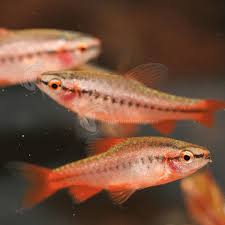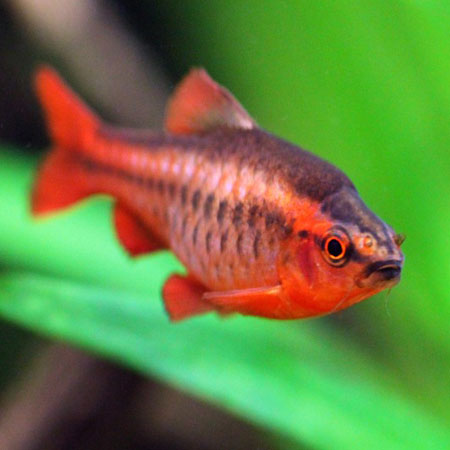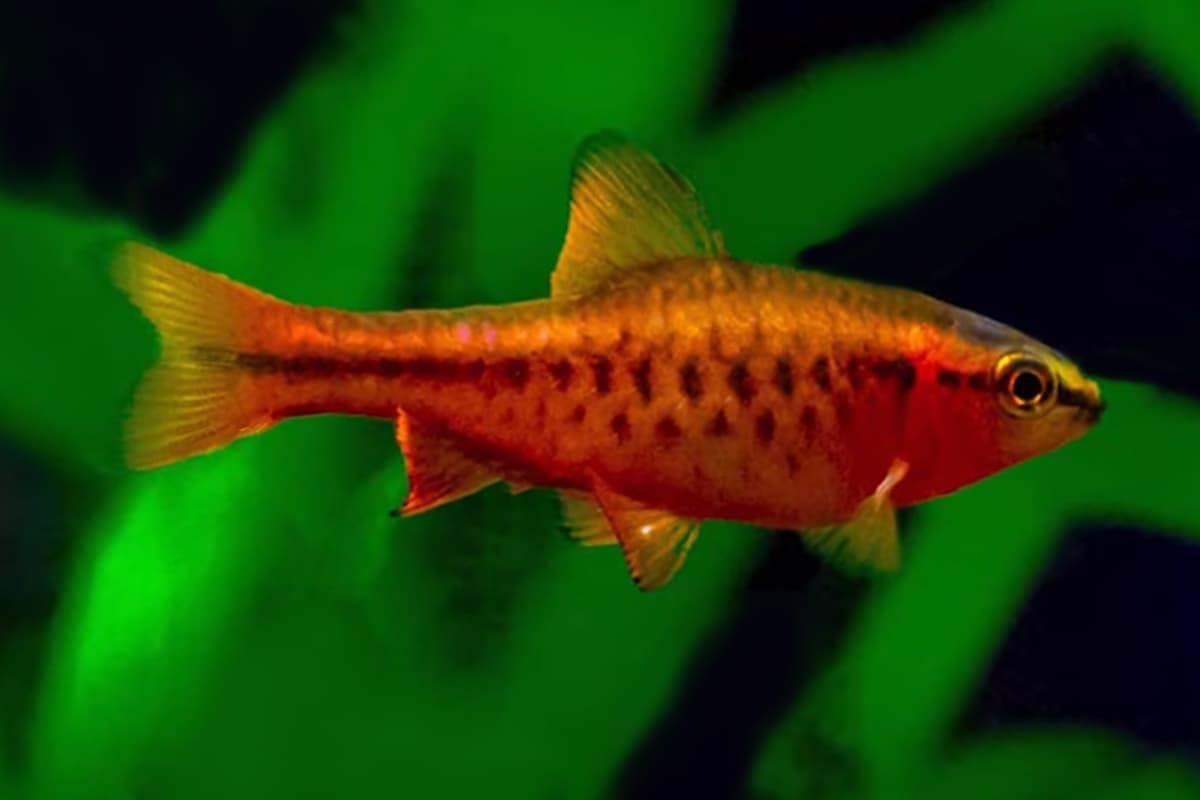Cherry Barb
A Splash of Ruby: The Ultimate Guide to Caring for Cherry Barbs in Your UK Aquarium

With their peaceful nature and the male’s stunning, cherry-red colouration, the Cherry Barb (Puntius titteya) is a jewel in the freshwater aquarium hobby. Hailing from the shaded streams and rivers of Sri Lanka, these delightful fish are an excellent choice for both beginner and experienced aquarists in the UK. This in-depth guide will provide you with everything you need to know to ensure your Cherry Barbs thrive, from tank setup and water parameters to diet, tank mates, and even breeding.
Natural Habitat and Why It Matters
Understanding the natural environment of a fish is crucial to recreating a suitable habitat in an aquarium. Cherry Barbs are found in the Kelani and Nilwala river basins in Sri Lanka. These areas are typically slow-moving, shallow, and heavily shaded by dense vegetation. The substrate is often silty and covered with leaf litter, which stains the water a tea-like colour and makes it soft and slightly acidic. By mimicking these conditions, you can significantly enhance the health, vibrancy, and longevity of your Cherry Barbs.
Setting Up the Perfect Cherry Barb Aquarium
Creating a comfortable and stimulating environment is the first step to happy and healthy Cherry Barbs.
Tank Size: While a small group can be kept in a 45-litre aquarium, a larger tank of at least 60 litres (approximately 15 gallons) is highly recommended. A longer tank is preferable to a taller one as it provides more horizontal swimming space.
Substrate: A dark-coloured substrate, such as fine gravel or sand, will not only mimic their natural environment but also beautifully contrast with the vibrant red of the male fish, making their colours pop.
Filtration: A gentle filtration system is ideal. Cherry Barbs are not accustomed to strong currents, so the outflow from your filter should be baffled or directed towards the glass. A sponge filter or a small internal filter with an adjustable flow rate is a great option.
Lighting: Subdued lighting is preferred. Bright lights can cause stress and wash out their colours. Using floating plants like Amazon Frogbit or Salvinia can help to diffuse the light and create a more natural, shaded feel.
Plants and Décor: A well-planted aquarium is essential for Cherry Barbs. They appreciate dense thickets of plants to explore and hide in, which makes them feel secure. Good plant choices include:
- Java Fern (Microsorum pteropus)
- Anubias species
- Cryptocoryne species (which thrive in lower light)
- Hornwort (Ceratophyllum demersum)
- Vallisneria species
Adding driftwood and a few smooth rocks will provide additional hiding places and contribute to a natural aesthetic. A handful of dried Indian Almond Leaves (Catappa leaves) can be added to the tank to release beneficial tannins, which can help to lower the pH slightly and have antibacterial properties.
Water Parameters: The Key to Health

Cherry Barbs are relatively hardy and can adapt to a range of water conditions. However, for optimal health and to encourage their best colouration, it’s important to maintain stable parameters within their preferred range.
| Water Parameter | Ideal Range | Notes for UK Aquarists |
| Temperature | 23-27°C (73-81°F) | An aquarium heater is essential in the UK to maintain a stable temperature. |
| pH | 6.0 – 7.5 | Most UK tap water is on the harder, more alkaline side. Using driftwood and Indian Almond Leaves can help to naturally lower the pH. You can also use a commercial pH buffer if necessary. |
| Hardness (GH) | 5 – 19 dGH | While they can tolerate a range, softer water is closer to their natural habitat and can encourage breeding. |
| Ammonia | 0 ppm | Crucial for all fish health. A cycled tank is a must. |
| Nitrite | 0 ppm | Also crucial. Ensure your tank is fully cycled before adding fish. |
| Nitrate | < 20 ppm | Keep nitrates low with regular water changes. |
Regular water changes are vital. A 25-30% water change every week will help to keep the water clean and the parameters stable. Always use a dechlorinator to treat tap water before adding it to the aquarium.
Diet and Feeding: A Varied Menu for Vibrant Fish
Cherry Barbs are omnivores and not particularly fussy eaters. In the wild, their diet consists of small insects, crustaceans, algae, and detritus. To ensure they receive all the necessary nutrients and to enhance their colour, a varied diet is essential.
A high-quality flake or micro-pellet food can form the basis of their diet. Supplement this with:
- Live or Frozen Foods: Daphnia, brine shrimp, and bloodworms are excellent treats and will be eagerly consumed.
- Vegetable Matter: Blanched spinach, shelled peas, or spirulina-based foods will provide essential vitamins.
Feed your Cherry Barbs once or twice a day, offering only what they can consume in a couple of minutes to avoid overfeeding and water quality issues.
Social Behaviour and Suitable Tank Mates
Cherry Barbs are peaceful, schooling fish and should be kept in groups. A school of at least six individuals is recommended. Keeping them in a group will make them feel more secure, leading to more natural behaviour and brighter colours in the males. The ideal ratio is one male to two or three females, as this will reduce any potential for males to harass a single female.
Their peaceful nature makes them excellent community fish. Here are some suitable tank mates:
| Compatible Tank Mates | Notes |
| Small Tetras | Neon Tetras, Cardinal Tetras, Ember Tetras |
| Rasboras | Harlequin Rasboras, Lambchop Rasboras |
| Danios | Zebra Danios, Leopard Danios |
| Corydoras Catfish | Bronze Corydoras, Peppered Corydoras |
| Small Loaches | Kuhli Loaches |
| Gouramis | Pearl Gouramis, Honey Gouramis (avoid larger, more aggressive species) |
| Other Peaceful Barbs | Gold Barbs, Rosy Barbs (in a larger tank) |
Avoid keeping Cherry Barbs with large, aggressive, or boisterous fish that may outcompete them for food or bully them. Fin-nipping species should also be avoided.
Breeding Cherry Barbs: A Rewarding Challenge

Breeding Cherry Barbs is relatively straightforward and can be a fascinating project for the home aquarist.
To encourage spawning, condition a breeding pair or a small group with plenty of high-quality live and frozen foods. The males will intensify in colour and may perform courtship displays for the females.
A separate breeding tank of around 20-30 litres is recommended. This tank should have soft, slightly acidic water with a temperature at the higher end of their preferred range (around 26-27°C). The tank should be heavily planted with fine-leaved plants like Java Moss or a spawning mop, as the female will scatter her eggs amongst them. Adding a layer of marbles to the bottom of the tank can also help to protect the eggs from being eaten by the parents.
After spawning, the adult fish should be removed as they will readily consume their own eggs. The eggs will hatch in about 24-48 hours, and the fry will become free-swimming a few days later. Initially, the fry are incredibly small and will need to be fed infusoria or a commercially available liquid fry food. As they grow, they can be transitioned to newly hatched brine shrimp and crushed flake food.
Common Health Issues
Cherry Barbs are generally robust fish, but like all aquarium inhabitants, they can be susceptible to common diseases, especially if water quality is poor or they are stressed.
- Ich (White Spot Disease): This parasitic infection appears as small white spots on the body and fins. It is often brought on by stress or sudden temperature changes. It can be treated with commercially available medications and by slowly raising the aquarium temperature.
- Fin Rot: This bacterial infection causes the fins to appear ragged and frayed. It is usually a result of poor water quality. Treatment involves addressing the water quality issues and using an antibacterial medication.
- Fungal Infections: These often appear as cottony growths on the body or fins and can be a secondary infection on an existing injury. Antifungal treatments are readily available.
The best way to prevent disease is to maintain excellent water quality, provide a suitable environment, and feed a varied, nutritious diet. Quarantining any new fish for a few weeks before adding them to your main aquarium is also a crucial preventative measure.
With their captivating colour and peaceful demeanour, Cherry Barbs are a fantastic addition to any well-maintained community aquarium. By following this guide, you can provide them with the care they need to flourish and bring a vibrant splash of ruby red to your underwater world for years to come.


